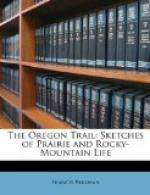events her sickness was sufficiently ill-timed and
unfortunate. I succeeded in a second attempt
to mount her, and with a slow pace we moved forward
on the trail of the Indians. It led us up a hill
and over a dreary plain; and here, to our great mortification,
the traces almost disappeared, for the ground was
hard as adamant; and if its flinty surface had ever
retained the print of a hoof, the marks had been washed
away by the deluge of yesterday. An Indian village,
in its disorderly march, is scattered over the prairie,
often to the width of full half a mile; so that its
trail is nowhere clearly marked, and the task of following
it is made doubly wearisome and difficult. By
good fortune plenty of large ant-hills, a yard or more
in diameter, were scattered over the plain, and these
were frequently broken by the footprints of men and
horses, and marked by traces of the lodge-poles.
The succulent leaves of the prickly-pear, also bruised
from the same causes, helped a little to guide us;
so inch by inch we moved along. Often we lost
the trail altogether, and then would recover it again,
but late in the afternoon we found ourselves totally
at fault. We stood alone without clew to guide
us. The broken plain expanded for league after
league around us, and in front the long dark ridge
of mountains was stretching from north to south.
Mount Laramie, a little on our right, towered high
above the rest and from a dark valley just beyond
one of its lower declivities, we discerned volumes
of white smoke slowly rolling up into the clear air.
“I think,” said Raymond, “some Indians
must be there. Perhaps we had better go.”
But this plan was not rashly to be adopted, and we
determined still to continue our search after the lost
trail. Our good stars prompted us to this decision,
for we afterward had reason to believe, from information
given us by the Indians, that the smoke was raised
as a decoy by a Crow war party.
Evening was coming on, and there was no wood or water
nearer than the foot of the mountains. So thither
we turned, directing our course toward the point where
Laramie Creek issues forth upon the prairie. When
we reached it the bare tops of the mountains were
still brightened with sunshine. The little river
was breaking with a vehement and angry current from
its dark prison. There was something in the near
vicinity of the mountains, in the loud surging of
the rapids, wonderfully cheering and exhilarating;
for although once as familiar as home itself, they
had been for months strangers to my experience.
There was a rich grass-plot by the river’s bank,
surrounded by low ridges, which would effectually
screen ourselves and our fire from the sight of wandering
Indians. Here among the grass I observed numerous
circles of large stones, which, as Raymond said, were
traces of a Dakota winter encampment. We lay
down and did not awake till the sun was up. A
large rock projected from the shore, and behind it
the deep water was slowly eddying round and round.




